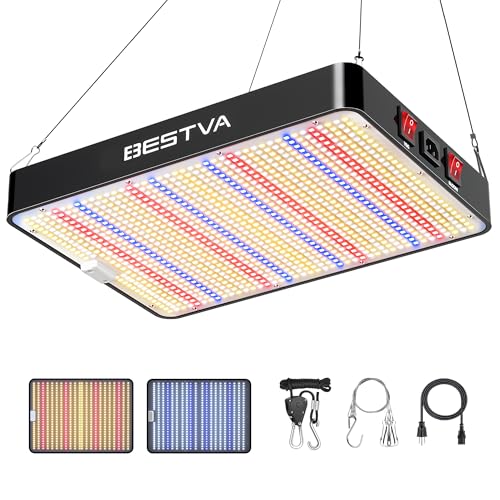The Queen Anthurium, native to South America, is renowned for its exquisite beauty, characterized by large, glossy leaves and velvety, dark purple flowers. This slow-growing tropical plant, a member of the Araceae family along with Monstera and Philodendron, can reach up to four feet in height, making it a striking addition to homes or offices. Unlike other anthuriums typically known for bright red, heart-shaped blooms, the Queen Anthurium stands out with its unique, long, and narrow leaves that possess a distinctive glossy sheen.
Distinguished by its vertical growth pattern, the Queen Anthurium requires support such as stakes or trellises to maintain its upright stature. This prevents any potential damage from bending or breaking. The plant’s flowers are equally unique, featuring a velvety texture and a deep purple hue that can appear almost black under certain lighting conditions. For those seeking a remarkable and unique tropical plant, the Queen Anthurium offers a visually stunning presence and, with proper care and attention, will provide years of lush foliage and striking blooms, transforming any space into a tropical oasis.
Genus Species



Anthurium warocqueanum is a beautiful plant that captures the hearts of plant lovers all over the world. This species, also known as Queen Anthurium, belongs to the genus Anthurium. The genus name Anthurium derives from Greek and Latin, meaning “flower” and “tail,” respectively.
The name is fitting for this particular species because of its unique tail-like structure and stunning flowers. The Queen Anthurium is native to South America, specifically in parts of Colombia and Ecuador.
Its striking appearance has captured many people’s attention in recent years, leading to an increase in demand. Its leaves can grow up to 3 feet long and 1 foot wide, making it a showstopper in any garden or indoor space.
The plant’s tail-like structure is actually made up of modified leaves called spathes that protect the small flowers within them. When it comes to care tips for Queen Anthurium plants, it’s important to note that they thrive in tropical environments with high humidity levels.
They prefer bright but indirect light and should not be exposed to direct sunlight as it can scorch their leaves. Additionally, they require well-draining soil that allows excess water to drain out quickly.
Propagation of Queen Anthuriums can be done through stem cuttings or division of rhizomes. It’s crucial when propagating this species that you use sharp tools since their stems are quite thick and tough.
If you’re looking for a stunning addition to your home or garden collection, look no further than the magnificent Queen Anthurium! With just a little bit of tender loving care with these care tips thrown in along the way , this plant will reward you with its beauty year after year!
Anthurium warocqueanum – Queen Anthurium Appearance
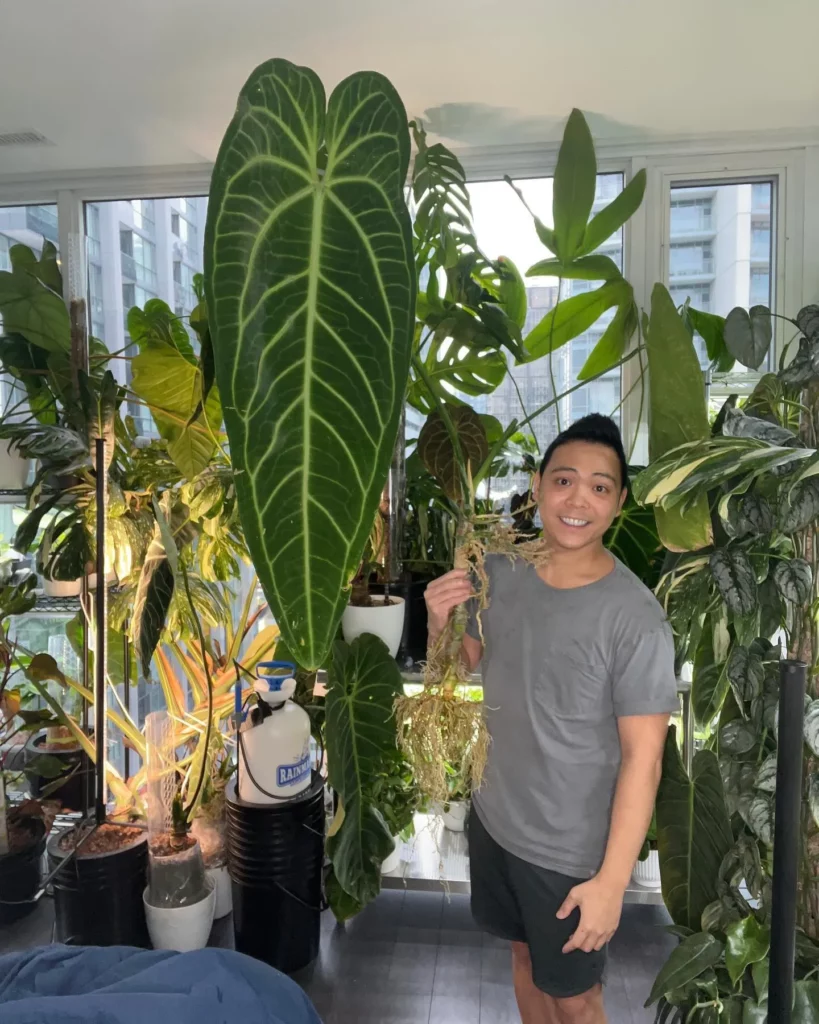
When it comes to appearance, Anthurium warocqueanum – Queen Anthurium is truly a queen. With its large, leathery leaves that can grow up to 3 feet long and 1.5 feet wide, this plant commands attention and makes for an impressive statement piece in any room.
The leaves themselves are dark green and velvety to the touch with prominent white veins that contrast beautifully against the rich green backdrop. But it’s not just the leaves that make this plant stand out.
The flowers of Anthurium warocqueanum are equally as stunning. They have a heart-shaped spathe (the modified leaf surrounding the spadix or inflorescence) that can grow up to 12 inches in length and a deep maroon color that fades to pink at the edges.
The spadix itself is typically yellow or green and can reach lengths of up to 6 inches. In terms of size, Anthurium warocqueanum is known for being one of the larger members of the Anthurium genus.
It can grow up to 6 feet tall in ideal conditions which means ample space is needed if you plan on growing this beauty indoors.
Care Tips: When it comes to displaying your Anthurium warocqueanum, consider placing it in a decorative pot with a sleek stand or placing it on top of a pedestal table where its beauty can be fully appreciated.
One thing worth noting about this plant’s appearance is that unlike some other species of Anthuriums, it doesn’t produce aerial roots which makes it easier to care for in terms of pruning. Overall, there’s no denying that when you bring home an Anthurium warocqueanum – Queen Anthurium, you’re getting a showstopper plant that will impress anyone who sees it.
Just make sure you have the space and the dedication to keep it looking its best.
Care Tips: To ensure your Anthurium warocqueanum remains healthy and happy, be sure to give it adequate space to grow and avoid overwatering which can lead to root rot.
How To Grow Anthurium warocqueanum – Queen Anthurium
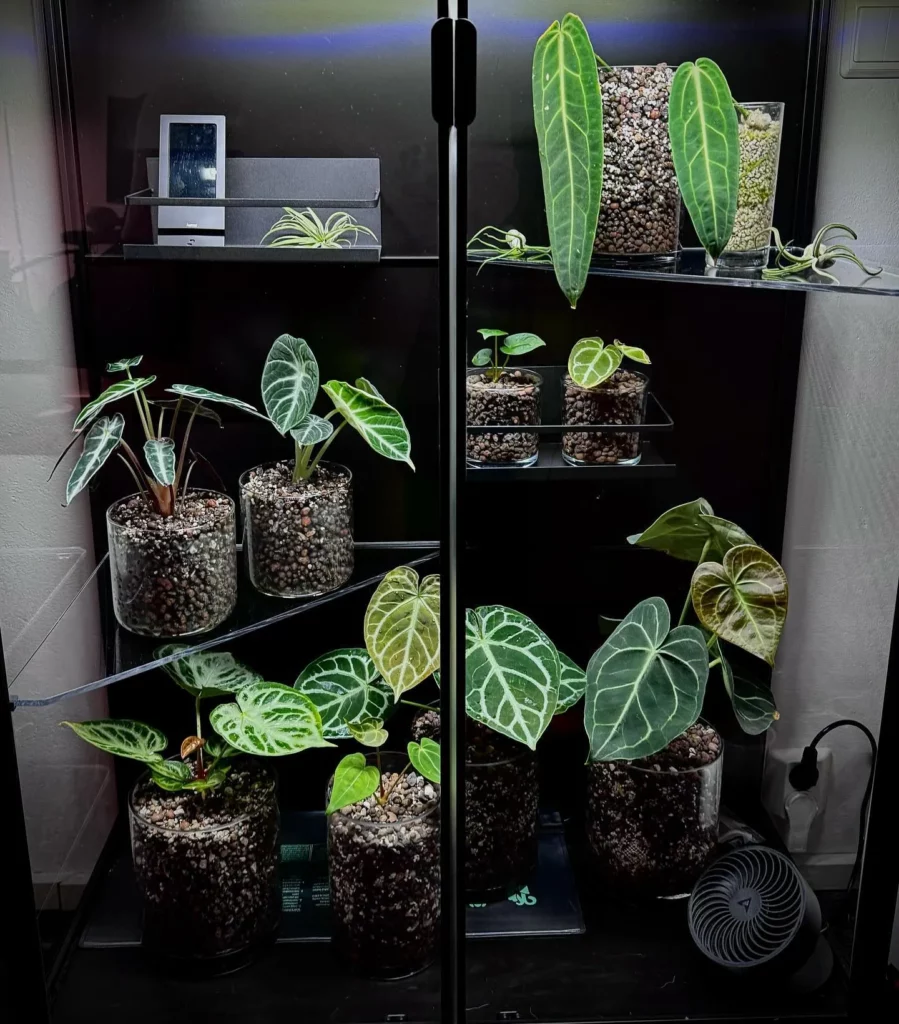
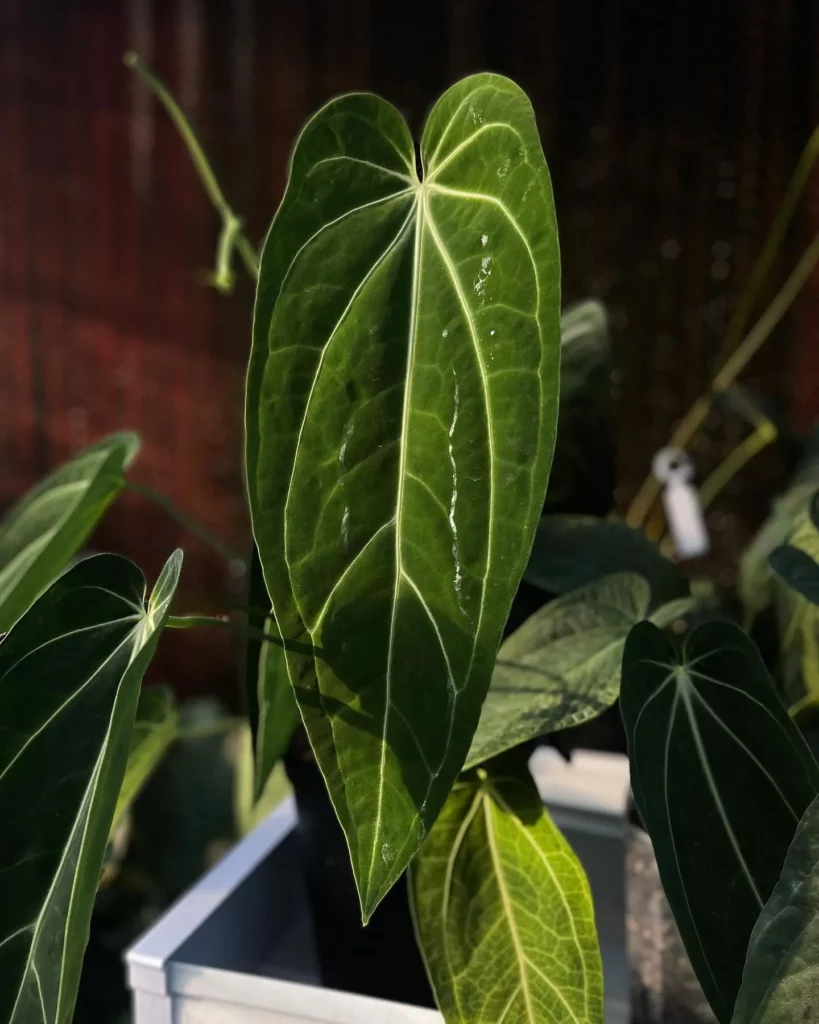

Growing Anthurium warocqueanum is not as easy as some other anthurium species, but the effort is definitely worth it. To begin with, it’s important to note that these plants are very slow-growing and can take a while to reach maturity. So, if you’re looking for a plant that will quickly fill up your empty space, this may not be the right choice for you.
The first thing to consider when growing Anthurium warocqueanum is the pot size. These plants prefer a tight fit when it comes to their roots, so choose a pot just slightly larger than the root ball.
A bigger pot will only encourage the plant to put its energy into growing roots instead of producing leaves and flowers.
Care Tips: Make sure that the soil in which you’re growing Anthurium warocqueanum is well-draining and rich in organic matter.
No products found.
The ideal soil mix should include peat moss or coconut coir, perlite or vermiculite, and some orchid bark or charcoal. Anthurium warocqueanum prefers bright indirect light but cannot tolerate direct sunlight for extended periods of time.
Care Tips: If you’re keeping your plant indoors, place it near a bright window without exposing it directly to the sun’s rays. If you’re keeping it outdoors, make sure that it’s planted under a shaded area.
Another crucial factor in growing healthy Anthurium warocqueanum is humidity levels. These plants thrive in environments where humidity levels are high – around 70%.
Care Tips: Consider using a humidifier or placing your plant on top of a tray filled with pebbles and water to increase humidity levels around your plant. By following these care tips and providing ideal conditions for growth like proper lighting conditions, soil type and moisture content as well as appropriate pruning techniques when necessary – you’ll be rewarded with beautiful blooms from this stunning tropical houseplant.
Anthurium warocqueanum – Queen Anthurium Propagation Tips

Propagation Tips: If you are looking to propagate the gorgeous Anthurium warocqueanum, you will be glad to know that it can be propagated through both division and stem cuttings.
Propagation is an excellent way to get more plants without having to spend a fortune. But before we dive into the different propagation methods, here are some care tips that you should keep in mind.
Care Tips: Make sure that you use a sterilized pair of scissors or pruning shears when taking a cutting or dividing your plant.
This will prevent any diseases from spreading to your plant. Avoid using any rusty or unclean tools as they can introduce harmful bacteria and pathogens.
Propagation through division is the easiest method of propagation for Anthurium warocqueanum. It involves separating the plant into two or more sections, each with its own roots attached to make new plants.
Before dividing, ensure that each section has at least one growth point and healthy roots system. Gently remove any dead or damaged roots and repot them in fresh, well-draining soil mix.
If you prefer propagating through stem cuttings, wait for a healthy shoot with two or three leaves before taking it out from its mother plant. Carefully remove the leaves from the bottom half of your cutting and dip it into rooting hormone powder if necessary before placing it in moist soil mix kept warm and humid for optimal root development.
Remember, successful propagation requires patience and consistency with proper care tips applied throughout the process. Once your new plants establish their roots system, follow our earlier mentioned guidelines for watering frequency as these newly propagated Anthuriums may not tolerate overwatering well until they are fully established in their new homes!
Anthurium warocqueanum – Queen Anthurium Quick Care Overview


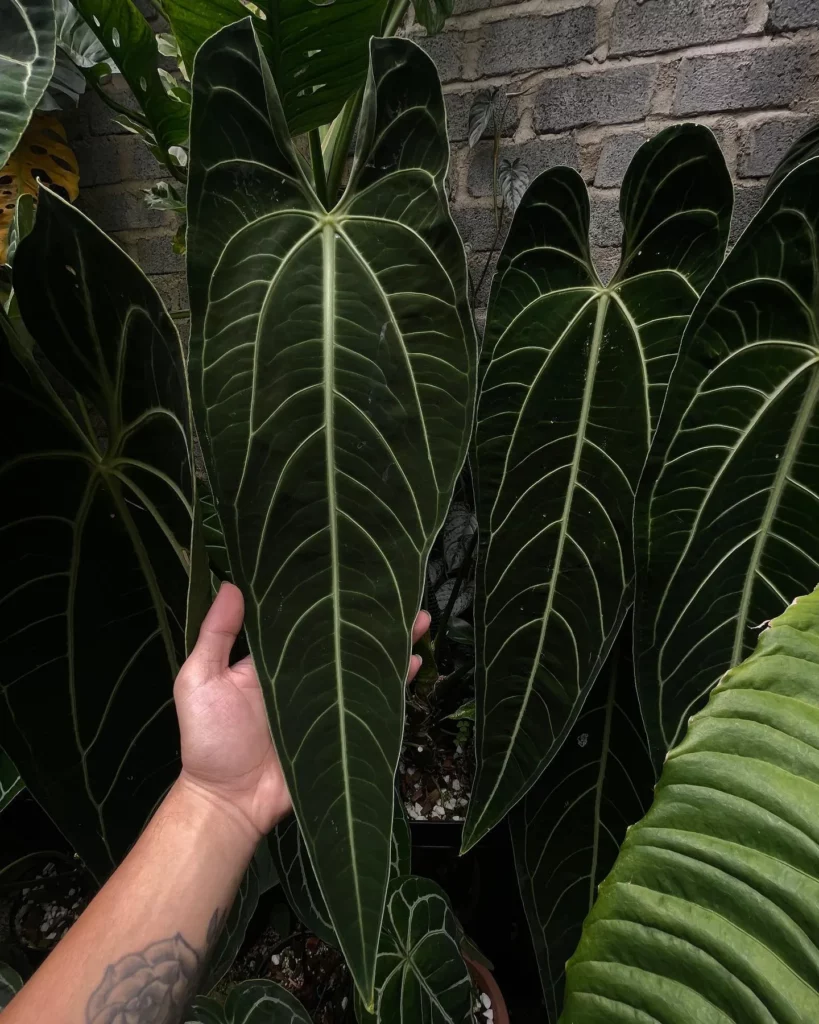
Quick Care Overview: Anthurium warocqueanum, or Queen Anthurium, is a stunning houseplant that must be included in your collection if you’re a true plant enthusiast.
The plant produces large and glossy leaves that give your space an exotic touch. It’s important to know that the Queen Anthurium is not easy to take care of – it requires attention and patience to thrive.
Here’s everything you need to know about its quick care overview. Firstly, let’s start with the basics: light requirements.
Anthurium warocqueanum prefers bright but indirect light – too much direct sunlight can lead to leaf burn, which can cause irreparable damage. To get the best results, place your plant near a bright window without exposing it directly to sunlight.
If you don’t have natural light in your home, an artificial grow light can come in handy. Next up are soil requirements – this species doesn’t require any special type of soil; however, ensure it has good drainage facilities as soggy soil can result in root rot or fungus growth which is not ideal for this plant type.
You could also add peat moss or orchid bark for additional nutrients and moisture retention capacity. Moving on to watering- as with most tropical plants adequate watering is necessary for proper growth however overwatering can kill these plants so it’s best practice to water when the top 1-2 inches of soil feels dry .
Since this species naturally grows on trees one could mimic their natural growing environment by misting leaves few times a week Care Tips: This emulates humidity levels the Anthurium requires. One of the most crucial aspects of keeping an Anthurium warocqueanum healthy is maintaining high humidity levels in its environment; they prefer around 70% humidity levels which are ideal for tropical houseplants .
A great tip would be placing a small humidifier next to your plant or alternatively placing a tray with water near your plant can also help achieve the desired humidity levels. Anthurium warocqueanum – Queen Anthurium is not an easy-to-maintain houseplant, but with the right conditions and care, it can add a beautiful touch to any space.
Remember to never expose this plant to direct sunlight, ensure proper drainage for soil, maintain adequate but not excessive watering frequencies, and provide the necessary humidity levels for healthy growth. With these tips in mind, you’ll be on your way to having a thriving Queen Anthurium in no time.
Anthurium warocqueanum – Queen Anthurium Light Requirements

Anthurium warocqueanum – Queen Anthurium is a striking plant, and its beauty stems from the contrast between its velvety dark green leaves and the magnificent red flowers.
But for those of us who love to keep plants indoors, it’s crucial to know how much light is needed to keep this stunning plant healthy. The first thing you need to understand is that Anthurium warocqueanum – Queen Anthurium loves bright but indirect light.
It’s vital that you don’t overexpose your plant to direct sunlight because the sun rays could scorch the leaves and make them turn yellow or brown. When placing your plant at home, ensure that it’s not too close to a window or in direct sunlight.
If you want your Anthurium warocqueanum – Queen Anthurium to thrive, make sure it gets about 5-6 hours of bright but indirect light per day. If you live in a place with low natural light, consider using artificial grow lights.
They are available at most garden stores and can help simulate natural sunlight.
Care Tips: If you notice that your plant is getting too much light or not enough, look out for signs of distress including yellowing leaves or wilting flowers.
If this happens, adjust the positioning of your plant until it gets adequate lighting. It’s important also to note that while the Anthurium warocqueanum – Queen Anthurium thrives in bright but indirect light conditions; it can adapt well under low-light conditions as well.
No products found.
However, under low-light conditions, the growth rate will be slow compared to when placed under bright conditions. Finding an ideal spot with good lighting for your Anthurium warocqueanum – Queen Anthurium is essential for its growth and beauty.
So always remember not to keep it in direct sunlight but rather bright but indirect light, and if need be, supplement with artificial light. With proper lighting, your Anthurium warocqueanum – Queen Anthurium will grow healthy and produce those gorgeous blooms for years to come.
Anthurium warocqueanum – Queen Anthurium Soil Requirements
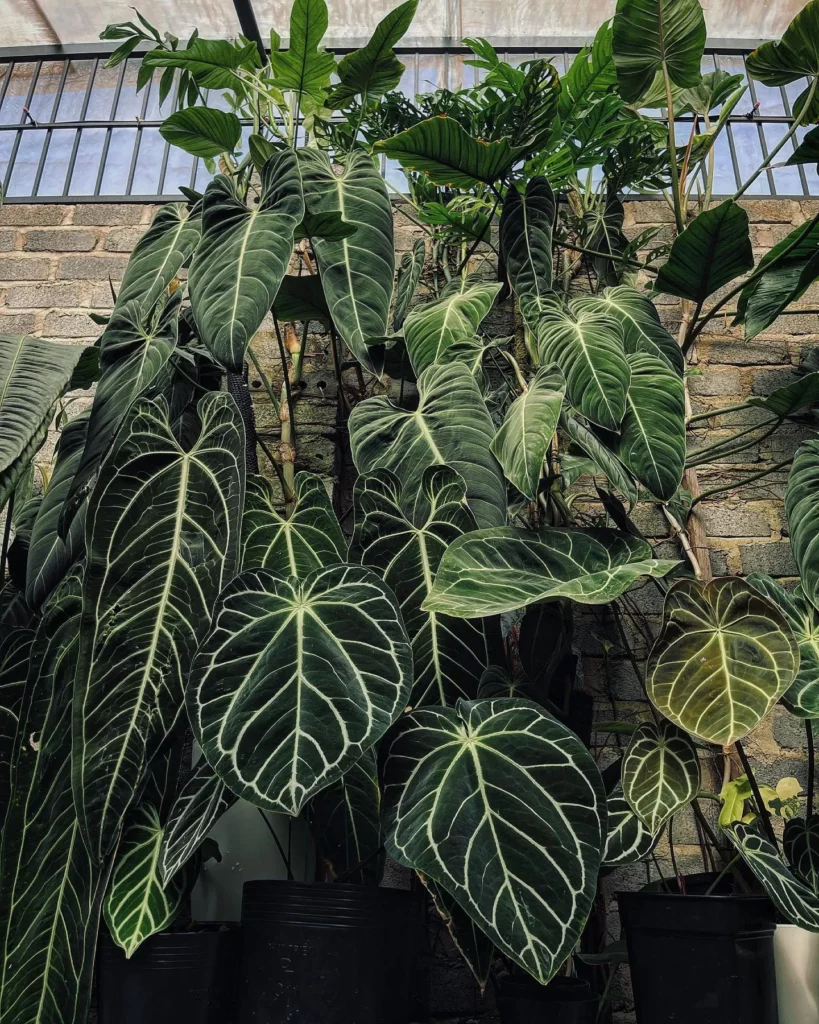


When it comes to cultivating the Anthurium warocqueanum, soil quality is essential.
The soil you use must not only provide the necessary nutrients for the plant but also have excellent drainage. Too much water can cause root rot, which could lead to the death of your plant.
Therefore, it’s crucial to ensure that you choose a soil mix that allows excess water to drain away quickly. The best soil for Anthurium warocqueanum is a mixture of orchid bark, perlite, and sphagnum moss.
These ingredients create an ideal combination of airiness and moisture retention that suits this tropical plant perfectly. The orchid bark provides stability for the roots while allowing oxygen to circulate freely around them.
Perlite offers additional drainage by loosening up the soil mix and preventing compaction. Sphagnum moss acts as a sponge by absorbing excess moisture and releasing it slowly over time.
This slow-release mechanism ensures that your Anthurium warocqueanum receives a steady supply of water without becoming waterlogged. Additionally, sphagnum moss contains several micronutrients that help nourish your plant’s roots.
To achieve optimal growth conditions for your Anthurium warocqueanum, you should repot it every year or two using fresh potting soil mix. This will give your plant access to fresh nutrients and prevent any potential buildup of salts or other harmful substances in the old soil mix.
Care Tips: Ensure that your potting medium is well-draining as too much water can be fatal for this beautiful tropical plant species! Always make sure you repot every year or two with fresh potting soils keeping in mind all nutrient requirements specific to Anthurium Warocqueanum!
Anthurium warocqueanum – Queen Anthurium Potting and Repotting

When it comes to potting and repotting your Anthurium warocqueanum or Queen Anthurium, plant owners need to be mindful of the size of their plants. These plants are known for their large leaves and growth rate, so it’s essential to choose the right container size that will provide enough space for healthy growth.
In general, a plant should be moved up in pot size only a little at a time. Moving up too much can cause too much soil moisture retention and cause root rot.
Since Anthurium warocqueanum prefers slightly moist but well-draining soil, it’s vital not to over-pot your plant. When repotting your Queen Anthurium, it is best to use high-quality commercial potting mix suitable for aroids.
The mix should contain peat moss or coir as its primary medium with added perlite or vermiculite and other organic materials like bark chips or composted pine needles. When choosing a new container, consider one that is no more than 2-3 inches larger than the current one as these plants like being snug in their pots.
Care Tips: Make sure that you inspect the roots of your plant before placing them into the new potting mix when repotting. Remove any old roots or dead/rotten material before placing them into fresh soil.
It’s also crucial to make sure that your new container has enough drainage holes at the bottom of the pot to allow excess water to escape quickly without soaking into the soil and causing root rot. In terms of timing, early spring is generally an excellent time for repotting if necessary because this is when most houseplants come out of their dormant period and begin actively growing again.
Care Tips: Do not fertilize your newly potted Queen Anthurium until after six weeks in its new home since fresh soil typically contains lots of nutrients already. Potting and repotting your Anthurium warocqueanum plant can be an exciting and fun experience if you follow these simple care tips.
Anthurium warocqueanum – Queen Anthurium Pruning and Shaping



Pruning and shaping your Anthurium warocqueanum – Queen Anthurium is essential to maintain a healthy and visually appealing plant. Pruning should be done regularly to remove dead or diseased leaves, stems, and flowers. It will also encourage new growth, making your plant lusher and bushier.
Shaping the plant can help create an aesthetically pleasing look that complements the space it occupies. Care Tips: When pruning, always make sure to use clean and sharp tools to avoid damaging the healthy parts of the plant.
Disinfecting your tools with rubbing alcohol before use is also a good practice as it can prevent the spread of diseases that may exist on other plants or surfaces. Be careful not to cut too much foliage at once as this may shock the plant and affect its growth.
When shaping your Anthurium warocqueanum – Queen Anthurium, consider its natural growth pattern and habits. The best way to shape these plants is using selective pruning techniques rather than shearing them into specific shapes or forms.
This approach allows you to create a more natural look while still controlling its overall size. Care Tips: Prune any branches growing in undesirable directions or crossing each other as they will compete for light and nutrients, which can weaken the plant over time.
Keep in mind that these plants have delicate roots; thinning out branches using selective pruning techniques will help minimize stress on their root system. If you’re looking for a more compact form for your Anthurium warocqueanum – Queen Anthurium, pinch off any new shoots from the stem tips periodically – this will stimulate branching at lower points on the stem, creating a fuller appearance.
Care Tips: Be sure not to overdo it when pinching back new shoots; this may cause unnecessary stress on the plant if done excessively. Only pinch off one or two sets of leaves at a time until you achieve the desired growth pattern.
Remember to use clean, sharp tools when pruning, keep its natural growth pattern in mind when shaping, and avoid overdoing it when pinching new shoots. By following these care tips, you can enjoy a beautiful and thriving plant that will enhance any indoor space.
Anthurium warocqueanum – Queen Anthurium Temperature Requirements

Anthurium warocqueanum or the Queen Anthurium is a tropical plant that is native to Colombia. It’s not just any ordinary houseplant; it’s a majestic ornamental plant that will make you feel like royalty.
However, growing and caring for this beauty can be a challenge, especially when it comes to maintaining the right temperature requirements. If you want your Anthurium warocqueanum to thrive, pay attention to these temperature requirements.
Temperature is an essential factor in the growth and development of any plant, and Anthurium warocqueanum is no exception. To keep your Queen Anthurium healthy, maintain temperatures ranging from 70° F (21° C) to 75° F (24° C) during the day and 60° F (15° C) to 65° F (18° C) at night.
Anything below or above these ranges can have adverse effects on your plant’s overall health. Care Tips: The ideal location for your Queen Anthurium would be in a bright room with filtered sunlight where temperatures are consistent and do not fluctuate too much throughout the day.
Avoid placing them near air vents or radiators as they prefer warmth without feeling direct heat. Anthurium warocqueanum likes high humidity levels ranging from 70% – 80%.
High humidity helps retain moisture in their leaves which prevents dehydration. If you live in an area with dry air, consider investing in humidifiers or set up trays of water near the plants as this can help maintain humidity levels.
Care Tips: Keep your Queen Anthurium away from drafts as they quickly lose moisture through their leaves when placed next to drafty windows or doors. It’s essential to understand that there are limits when it comes to temperature tolerance for this species of Anthurium.
Temperatures below 50°F (10°C) can damage their foliage while anything above 90°F (32°C) can cause wilting and leave your plant vulnerable to pests or diseases. In the long run, this could lead to severe damage or even death.
Care Tips: During winter, keep your Anthurium warocqueanum away from windowsills that get too cold at night. Similarly, during summer, avoid placing them in direct sunlight as it can expose them to temperatures higher than what they can tolerate.
No products found.
Maintaining the right temperatures is crucial when it comes to growing and caring for your exotic Anthurium warocqueanum. Keep your plant in an environment with consistent temperatures between 70°F (21°C) – 75°F (24°C) during the day and 60°F (15°C) – 65°F (18°C) at night.
Avoid placing them near radiators or air vents that could expose them to direct heat or cold air drafts that may dehydrate their leaves. With proper care and attention, you’ll be rewarded with a healthy and vibrant Queen Anthurium that’s fit for royalty!
Humidity Requirements

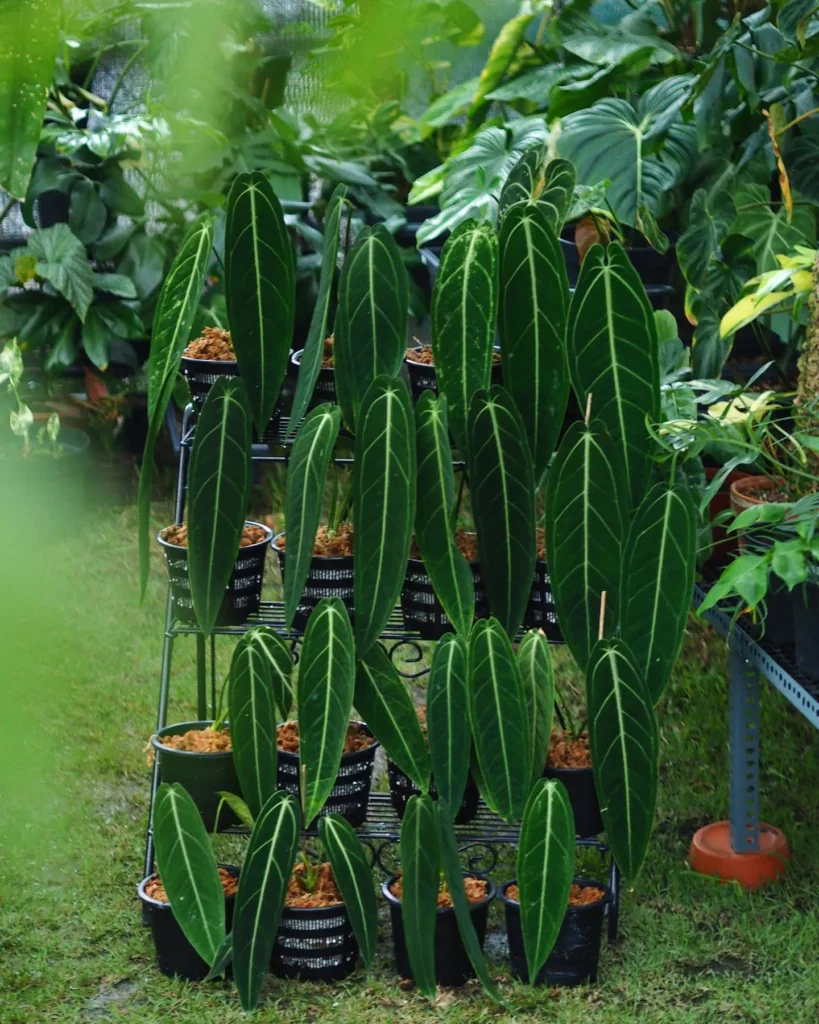
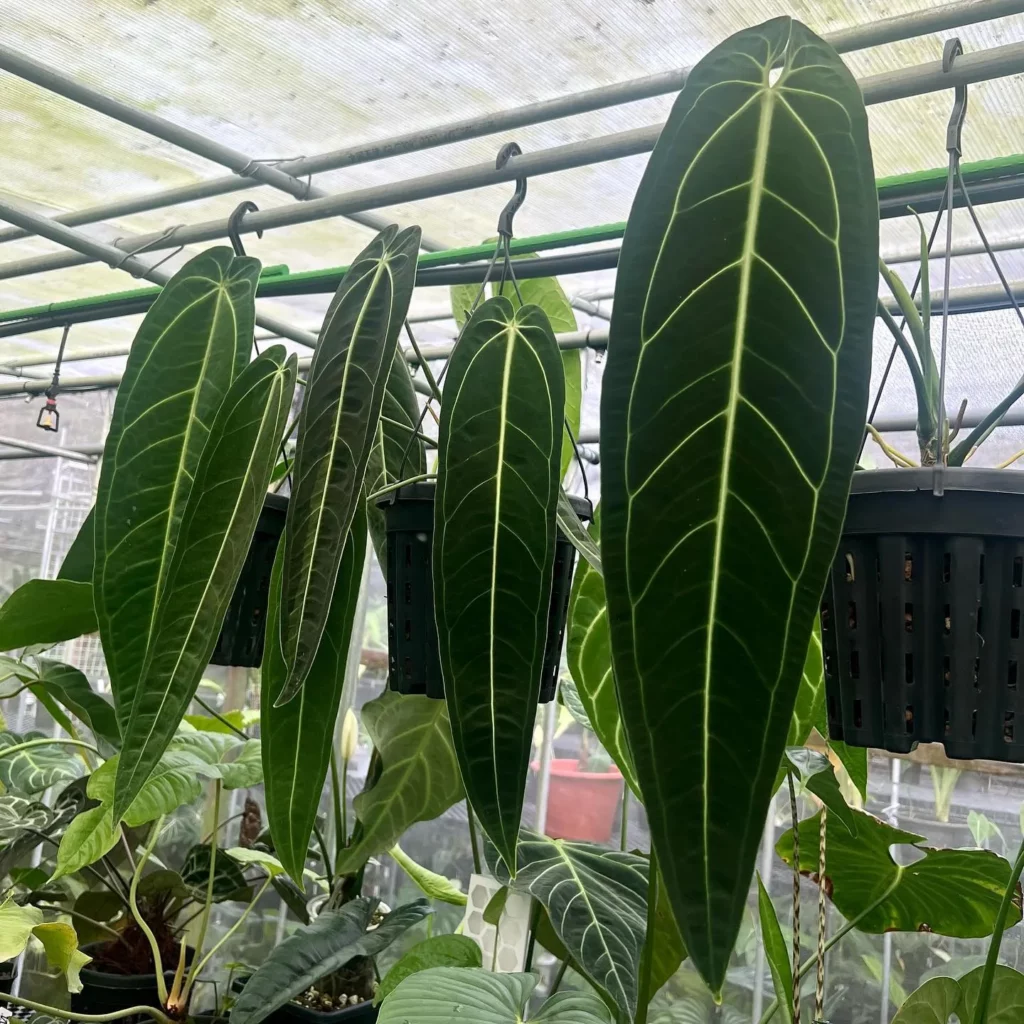
Anthurium warocqueanum – Queen Anthurium is a tropical plant that thrives in high humidity. If you want to keep the Queen Anthurium alive, you have to make sure that it’s getting enough moisture in the air.
The ideal humidity level for the plant would be around 70-80%, which is not achievable in most houses without a bit of help. You can use a humidifier or make a pebble tray to increase the humidity level around your Queen Anthurium.
Care Tips: You should always keep an eye on the humidity level around your plant. If you notice that it’s too low, you should consider using any of these methods to increase it.
Dry air can cause brown spots and leaf tips on your Queen Anthurium, which isn’t something you want. Another option for increasing humidity levels is grouping plants together or placing them in a naturally humid area of your home such as a bathroom or kitchen.
Be mindful of drafts from windows or vents as they can quickly dry out the leaves and increase transpiration. One thing to note is that if the air gets too humid, then there’s a possibility of fungal growth which can be harmful to your plant’s health.
This is why it’s crucial to find the perfect balance between too little and too much moisture. Care Tips: In case you notice any signs of fungal issues like powdery mildew on leaves or stem rot, reduce excess moisture immediately by cutting back on watering frequency and ventilating your space more often.
Maintaining proper humidity levels for your Queen Anthurium isn’t rocket science but requires some attention and care on our part as growers. By providing adequate moisture through any suitable method mentioned above and monitoring closely for signs of trouble, we can keep our beloved plants healthy and vibrant for years to come!
Watering Anthurium warocqueanum – Queen Anthurium
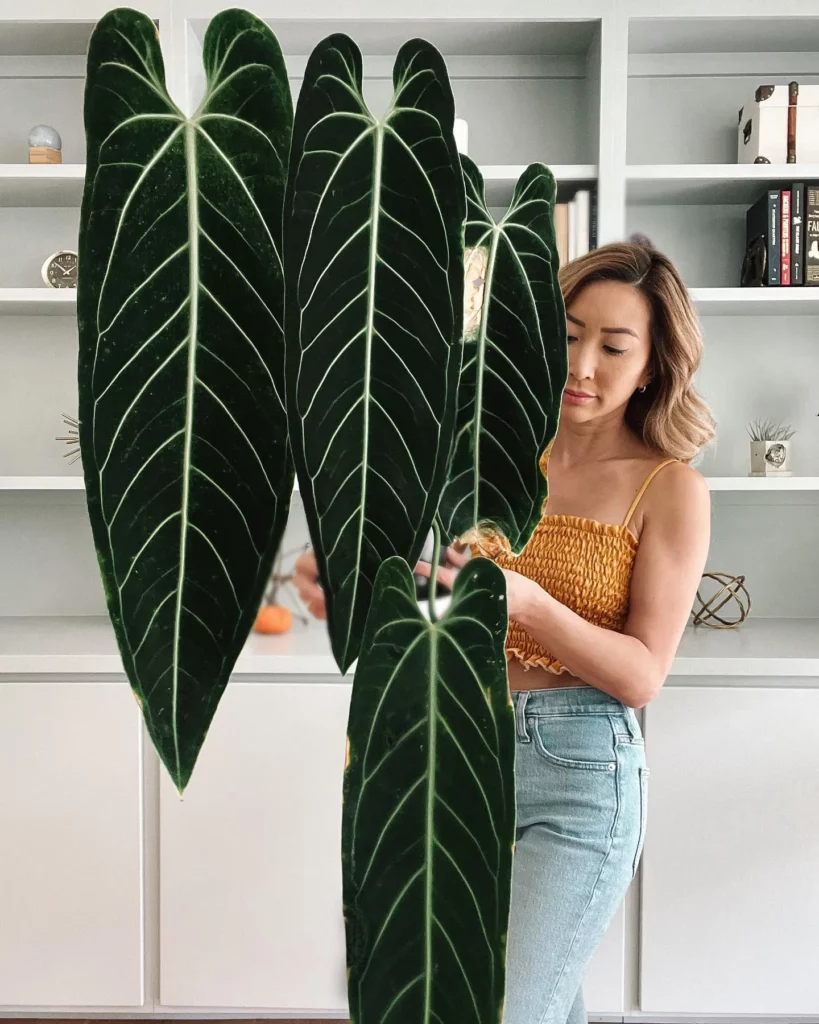
It is important to know how to water an Anthurium warocqueanum – Queen Anthurium plant properly. They are sensitive to overwatering and can easily get root rot if they are not watered correctly.
The key to watering this plant is to keep the soil moist but not soggy. In this section, we will discuss proper watering techniques and care tips for your Anthurium warocqueanum – Queen Anthurium.
Firstly, it’s best to use a well-draining potting mix that allows the excess water to drain quickly. This helps prevent any standing water in the soil which could lead to root rot.
It’s also important not to let the soil dry out completely between watering as it can cause the leaves of your plant to wilt and dry up. The ideal method of watering your Anthurium warocqueanum – Queen Anthurium is by pouring water directly onto the soil until it drains out through the drainage holes at the bottom of your pot.
It’s also recommended that you use lukewarm or room temperature water when watering as cold or hot water can damage your plant’s roots.
Care Tips: When you find that your plant needs extra moisture, try using a humidifier near your plant or place a tray of pebbles filled with water underneath it.
As an added bonus, misting its leaves with room temperature non-chlorinated distilled or rainwater can help increase humidity levels and make sure their beautiful foliage stays healthy. In terms of frequency, you should aim for once a week during warm months and every two weeks during cooler months for most locations worldwide; however, always adjust accordingly based on factors such as humidity levels and air flow in your home.
Fertilizing Anthurium warocqueanum – Queen Anthurium
When it comes to fertilizing your Anthurium warocqueanum – Queen Anthurium, please do yourself and your plant a favor by avoiding synthetic fertilizers. Synthetic fertilizers may provide an immediate nutrient boost, but they are often harmful in the long run.
They can damage the soil quality and lead to a buildup of salts and chemicals in the soil, which can have negative effects on your plant’s health. Instead, opt for organic fertilizers, such as compost or worm castings.
These natural alternatives provide slow-release nutrients that are perfectly suited for your Anthurium warocqueanum – Queen Anthurium’s needs. Not only do they nourish your plant with essential elements like nitrogen, phosphorous, and potassium, but they also improve the overall health of your potting mix by increasing its fertility and water retention capacity.
Care Tips: When applying organic fertilizers to your plant’s soil, make sure you use them sparingly. Over-fertilization can cause root burn or other issues that will damage or kill your plant.
Always follow the instructions on the package carefully and avoid getting any fertilizer on the leaves or flowers of your Anthurium warocqueanum – Queen Anthurium. Another natural option for feeding your queen anthurium is using fish emulsion fertilizer.
This type of fertilizer is made from ground-up fish parts and has a pungent smell that may not be appealing to some gardeners but it is worth it when you see how well this fertilizer works. Fish emulsion contains nitrogen as well as other beneficial nutrients like calcium and magnesium which promotes healthy growth in all types of plants including tropicals like anthuriums.
Care Tips: Fish emulsion should be applied once a month during spring through summer growing season at half strength new plants should be allowed to settle into their new home for 4 to 6 weeks before being fertilized. Avoid over-fertilizing, which can cause root burn or other issues that will damage or kill your plant.
Using organic fertilizers like compost, worm castings, and fish emulsion are great ways to ensure your Anthurium warocqueanum – Queen Anthurium is getting the nourishment it needs to thrive. These natural alternatives promote healthy growth without causing harm to the plant or soil quality.
Pest Control Tips for Anthurium warocqueanum – Queen Anthurium
Every plant owner wants their plants to be healthy and thriving. However, sometimes, pests can cause serious damage to your Anthurium warocqueanum – Queen Anthurium. Here are some pest control tips that can help you keep your plant safe and healthy.
One of the most common pests that can harm your Anthurium warocqueanum – Queen Anthurium is spider mites. These tiny creatures are barely visible to the human eye, but they can cause a lot of damage to your plant.
Spider mites love dry conditions, so make sure you keep the humidity levels high around your plant. If you notice any signs of spider mites on your plant, use a solution of neem oil and water to get rid of them.
Neem oil is a natural pesticide that is safe for plants. Another pesky creature that can infest your Anthurium warocqueanum – Queen Anthurium is mealybugs.
No products found.
These soft-bodied insects feed on plant sap and excrete honeydew, which attracts ants and promotes fungal growth. To keep mealybugs at bay, try using an alcohol solution to clean the affected leaves and stems.
Alternatively, you can use an insecticidal soap or neem oil spray for effective control. Fungus gnats are another common pest that can damage your Anthurium warocqueanum – Queen Anthurium’s root system by feeding on its roots and laying their eggs in its soil.
To prevent fungus gnats from infesting your plant’s soil, avoid overwatering or leaving standing water in its saucer or pot tray for extended periods Care Tips concerning watering frequency will help reduce their population as well). Yellow sticky traps placed near the soil surface will help catch flying adults.
If none of these remedies work and pests still persist it may be necessary to use either chemical pesticides or contact an expert for further assistance with pest control. Always use pesticides with caution and follow manufacturers’ instructions carefully.
Be aware that regular use of chemical pesticides can be harmful to the environment, so try non-toxic alternatives first before resorting to chemicals. With these pest control tips, you can keep your Anthurium warocqueanum – Queen Anthurium healthy and thriving for years to come.
Anthurium warocqueanum – Queen Anthurium Common Problems
Let’s talk about some of the common problems that you may face while caring for an Anthurium warocqueanum – Queen Anthurium plant. This section will cover some of the most prevalent issues that people encounter and offer potential solutions to these problems.
One of the most common issues with Anthurium warocqueanum is leaf discoloration. You may notice that the leaves are turning yellow or brown, or they are developing spots.
The first thing you want to do is check your watering habits and make sure you aren’t overwatering your plant. Overwatering can lead to root rot, which causes leaf discoloration.
To remedy this issue, allow the soil to dry out between waterings and adjust your watering schedule accordingly. Another issue with Anthurium warocqueanum is pest infestations.
These pests can include mealybugs, spider mites, and scale insects. If left untreated, these pests can cause serious damage and even death of the plant.
To prevent pest infestations, it’s essential to keep a close eye on your plant’s health and inspect it regularly for any signs of pests. Care Tips: Use organic insecticides like neem oil or soap sprays to eliminate these pesky critters from your plant.
Root rot is another common problem encountered while growing anthuriums, especially if you’re not using appropriate soil drainage techniques. It occurs when there is too much moisture in the soil leading to fungal diseases which rot roots making them less efficient at absorbing nutrients thereby stunting growth or causing wilting leaves.
Care Tips: Always use well-draining potting mix while planting anthuriums; maintain proper air circulation in humid conditions by keeping fans running around them; don’t keep them in excessively wet conditions Improper light exposure can lead to anthuriums not blooming.
If the plant doesn’t receive proper light, it won’t bloom. Lack of enough light causes the plant to produce leaves only and no flowers, or fewer than usual.
Care Tips: Provide bright, indirect light for at least eight hours a day to ensure your anthurium produces flowers. Keep them near a south-facing window where they can get filtered sunlight throughout the day.
Frequently Asked Questions
Anthurium warocqueanum requires a bit more attention and care compared to some other houseplants. It prefers bright, indirect light, high humidity, and consistently moist but not soggy soil. Regular monitoring of its environmental conditions and proper care will ensure its well-being.
Anthurium warocqueanum thrives in bright, indirect light and prefers temperatures between 65-80°F (18-27°C). It requires high humidity levels, ideally around 60-80%, which can be achieved through misting or using a humidifier. Watering should be done when the top inch of soil feels slightly dry, and it’s important to avoid overwatering to prevent root rot.
Yellowing leaves on Anthurium warocqueanum can be a sign of various issues, including overwatering, underwatering, inadequate light, or nutrient deficiencies. It’s important to assess the plant’s watering schedule, ensure it’s receiving proper light levels, and consider fertilizing regularly with a balanced houseplant fertilizer to provide essential nutrients.
No, Anthurium warocqueanum does not prefer to be root bound. It is generally recommended to repot Anthurium warocqueanum every 1-2 years, or when the roots have filled the current pot. Providing a slightly larger pot with fresh, well-draining soil allows the plant’s roots to have sufficient space for growth and prevents the plant from becoming root bound.
After reading this, check out our other articles on:
Conclusion
Anthurium warocqueanum – Queen Anthurium is a stunning plant that requires a bit of extra effort to care for, but the results are well worth it. With its giant leaves and velvety texture, it is sure to make a statement in any room.
The key to success with this plant is providing it with the right environment: bright indirect light, high humidity, and moist but well-draining soil. When it comes to watering your Anthurium warocqueanum – Queen Anthurium, always make sure you’re not over or under-watering it.
Use lukewarm water and avoid getting water on the leaves as that can lead to bacterial growth or fungal infection. Fertilize your plant occasionally during the growing season using balanced houseplant fertilizer.
If you want to propagate your Anthurium warocqueanum – Queen Anthurium, use stem cuttings with at least one node and place them in a pot filled with moist soil mix and cover with plastic wrap until roots form. Once your new plants have grown large enough, remember to repot them into larger containers so they can continue growing.
Overall, caring for an Anthurium warocqueanum – Queen Anthurium may seem intimidating at first but once you get the hang of it you’ll be rewarded with beautiful foliage year-round. With these care tips in mind, you’ll be able to keep your plant healthy and thriving for years to come!





